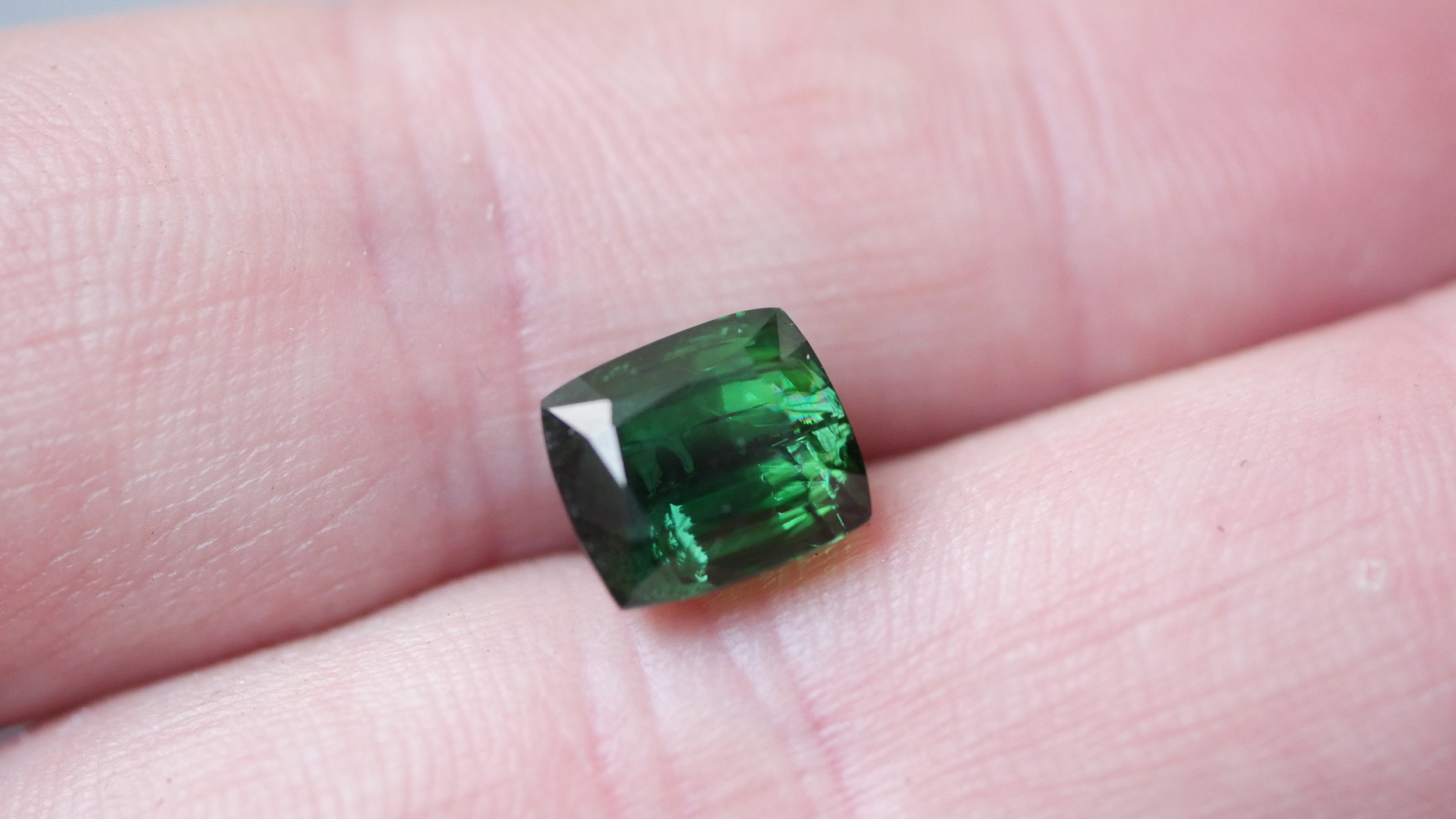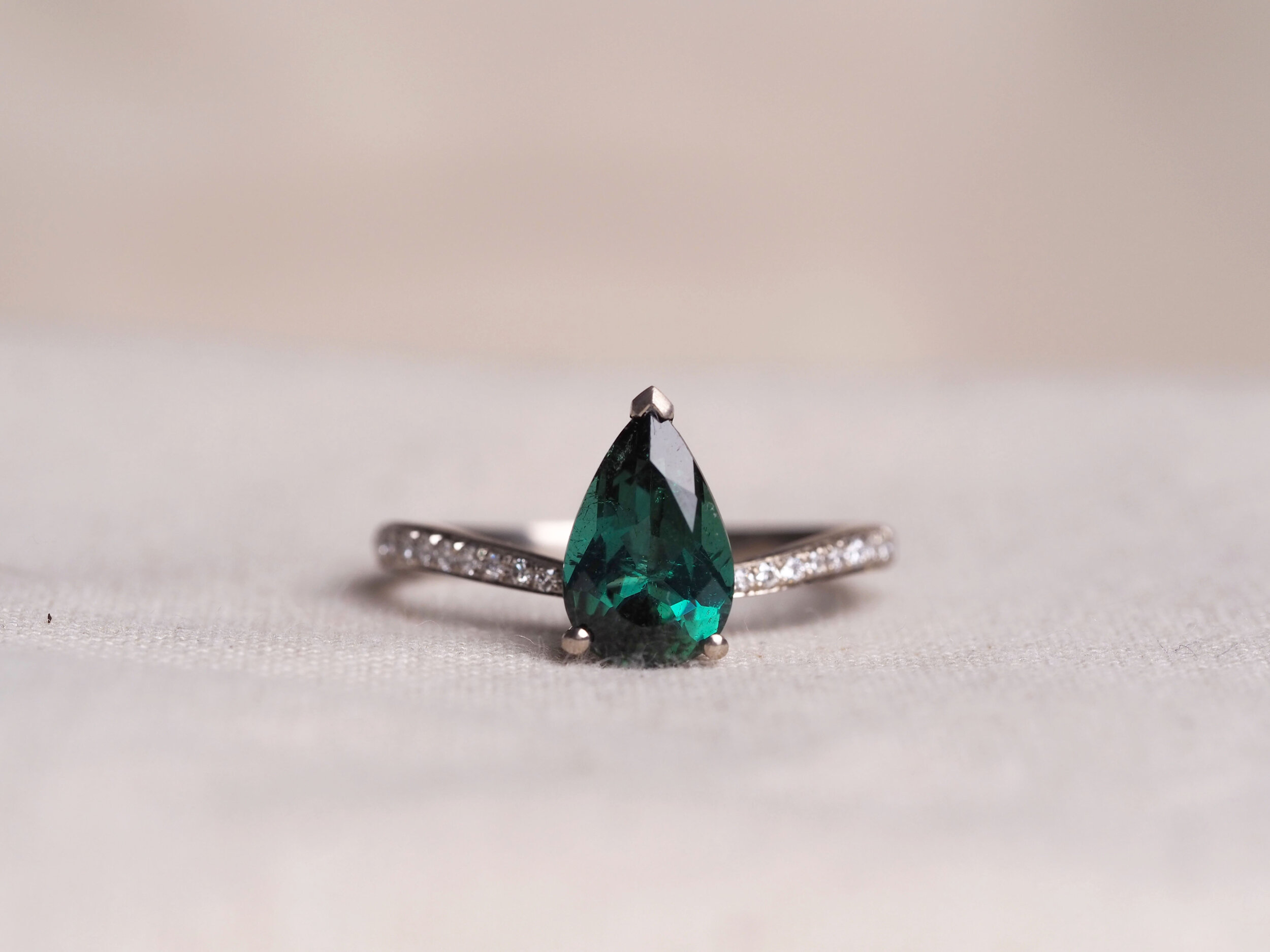Tourmaline
Tourmalines are one of the most versatile gemstones around. They come in a wide variety of colours; you can even get stones that vividly show 2 or even 3 colours in one stone, such as watermelon tourmaline. This is known as pleochroism. They also occupy a special place in my heart, as they were the first gemstone that I bought directly from miners when I travelled to Namibia in 2015.
Tourmalines can be found all over the world and there are many different varieties. Some are specific to certain locations, like Paraiba tourmalines. A bright blue variety of tourmaline, which is amongst the worlds most valuable gemstones. This is mostly owed to the small yield of the mines where Paraiba tourmalines are found, these stones can definitely be considered rare gems.
What is Tourmaline?
Tourmaline is the name given to a group of related mineral ‘species’, collectively known as tourmalines. They are a semi-precious gemstone and the different colours are known by different names.
Tourmalines have a very complex composition and it’s the various different chemicals that give rise to the array of colours that tourmalines come in. They are a crystalline boron silicate mineral compounded with aluminium, iron, magnesium, sodium, lithium, copper, or potassium.
Some of the different colours are also known by names that make them easier to categorise; these can be referred to as ‘trade names’, as they are primarily used by the jewellery and gemstone trade.
Rubellite - Red, purplish-red, orangey-red, or brownish red tourmaline. The exact colour of Rubellite can vary and some of the best examples are comparable to rubies and pink sapphires.
Indicolite - Blue
Paariba - Bright neon blue
Chrome - Intense green
Canary - Yellow
Watermelon - A stone with both green and red/pink colouring
Other colours of tourmaline are simply known by their colours, for instance ‘pink tourmaline’ or ‘black tourmaline’.
A distinctive property of tourmalines is that they are di-chroic, meaning that they can exhibit different colours or tone when viewed from different angles.
The History of tourmaline
Tourmalines were known to the Ancient Egyptians and, according to legends from the time, tourmalines gained their myriad of colours when they passed through a rainbow as they rose from the earth. The Dutch East India Company were responsible for bringing gem-quality stones to Europe from Sri Lanka.
Spanish conquistadors found tourmaline in Brazil in the 1500s, however, these were mistaken for emeralds at the time. It was only in the 180’s that gemmologosts were able to consistently identify and categorise tourmaline minerals into and separate groups.
Oval cut, Green Tourmalines
Underside of green tourmaline
Tourmaline crystals
Tourmaline crystals have a unique shape, which helps to identify them from other minerals. The exact crystal structure and composition differ from species to species however generally, tourmaline crystals are long and slender. This is why you often see tourmalines cut into shapes like emerald cuts, pear shapes, and ovals as these shapes maximise the yield from the crystal.
Tourmaline crystals can often be found growing in clumps and groups, making for some spectacular mineral samples, crystals which are not cut into stones for use in jewellery but are left intact for display.
How hard is Tourmaline?
Tourmalines measure 7-7.5 on the Mohs scale of Mineral hardness which makes them suitable for wearing in jewellery, although frequent wear in rings will cause the stone to chip and wear down.
This is why you are advised not to wear a tourmaline in an engagement ring, as these items of jewellery are typically worn constantly. Tourmalines are best suited to earrings, pendants, and rings that will be worn occasionally.
How to care for tourmalines
Jewellery that contains tourmalines can be cleaned in an ultrasonic cleaner and no special care needs to be given to them. When storing, it is best to avoid contact with gemstones that measure anything above a 7 on the Mohs scale, for instance, sapphires, rubies, or diamonds, as they can cause scratches.
Where do tourmalines come from?
Tourmalines are found in many locations around the world, but there are a few places that are well known for producing high-quality stones.
Brazil - The state of Minas Gerais in Eastern Brazil is home to many gemstones and is the world’s leading source of tourmalines. Tourmalines of all colours are found here and some of the best examples of tourmalines, especially watermelon tourmalines, have been found here. The state of Minas Gerais is home to many other gemstones and mineral products account for almost half of the state’s exports.
Brazil is home to the ‘Paraiba tourmaline’ which is a variety of tourmaline that has an intense turquoise blue colour given to it by traces of copper. This is the most expensive variety of tourmaline and ranks as one of the most expensive gemstones in the world. The first examples of these stones were discovered as recently as the 1980’s by Heitor Dimas Barbosa in the state of Paribaba.
Namibia - The Erongo mountains in central Namibia are home to tourmaline mines and have produced stones of all colours over the years. Black tourmaline crystals are particularly abundant here and blue, green, and pink tourmaline of good size and quality can be found.
Rough green tourma,ione
Afghanistan - Tourmalines from Afghanist are becoming known for their distinctive electric greens and overall size and quality.
TOURMALINE MINING
Tourmaline mining is often small scale and conditions can be basic. This can present dangers to miners however it does provide the opportunity for riches and provides a source of income in areas which are often remote and underdeveloped.
Green cushion cut Tourmaline from Namibia
HOW VALUABLE IS TOURMALINE?
How valuable a tourmaline is depends on a few different criteria. Some, like size, colour, and clarity are the same as with any other gemstone, however the chemical composition of tourmaline can have a dramatic effect on its value, as can the locality of the mines.
How well a tourmaline is cut can have a dramatic effect on the value of the stone because of di-chroic properties of the stone and the different colours you can see when looking at the stone along a different axis.
As discussed, Paraiba tourmalines, which are bright blue in colour due to high levels of copper, are one of the most valuable gemstones in the world. However, bright blue tourmalines with traces of copper have also been found in other locations since the initial discovery in 1988. There are also blue tourmalines that do not contain copper. If copper is found to be present in a tourmaline, then this can dramatically increase its value. If copper is present in stone AND it comes from Paraiba then the value will be increased even more.
WATERMELON TOURMALINE
A tourmaline that has both green and red colours is known as a ‘watermelon tourmaline’ as it resembles the colouring of a watermelon. Large stones with good clarity that have this colouring are very highly sought after and are very expensive.
Crystals found with this colouring are often cut into slices.
An Emerald cut watermelon Tourmaline. Image by @sabrinnaringquist
Blue Green, pear cut Tourmaline in 18ct Fairtrade white gold ring.
As well as our own personal experience, a lot of the information used in this article comes via the GIA and mindat.org. If you are interested in tourmaline gemstones and minerals, we suggest checking these sites out.








